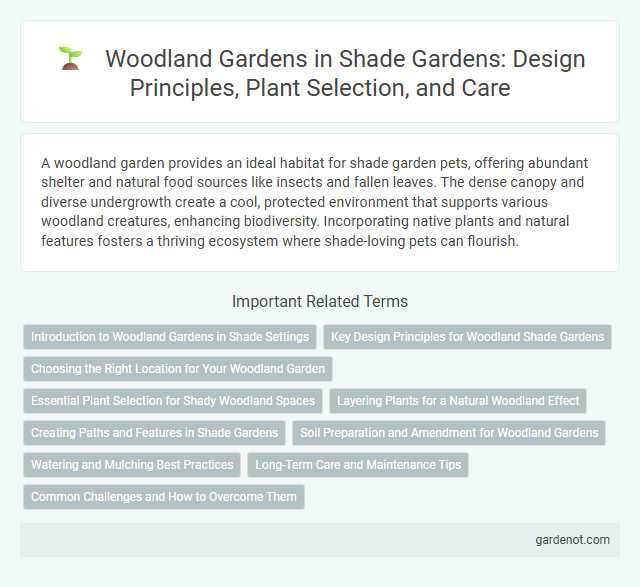A woodland garden provides an ideal habitat for shade garden pets, offering abundant shelter and natural food sources like insects and fallen leaves. The dense canopy and diverse undergrowth create a cool, protected environment that supports various woodland creatures, enhancing biodiversity. Incorporating native plants and natural features fosters a thriving ecosystem where shade-loving pets can flourish.
Introduction to Woodland Gardens in Shade Settings
Woodland gardens thrive in shaded environments by mimicking natural forest ecosystems with layered plantings of trees, shrubs, and groundcovers. These gardens emphasize native shade-tolerant species such as ferns, hostas, and woodland wildflowers that create a lush, textured landscape. Proper soil preparation and moisture management are crucial for maintaining healthy plant growth in these low-light, high-humidity conditions.
Key Design Principles for Woodland Shade Gardens
Woodland shade gardens thrive through the use of layered planting, combining towering trees, mid-level shrubs, and groundcover to mimic natural forest ecosystems while enhancing biodiversity. Emphasizing native species selection ensures adaptability and sustainability, promoting healthy soil and ecosystem balance. Incorporating meandering pathways and natural mulch supports moisture retention and easy garden access, preserving the delicate woodland environment.
Choosing the Right Location for Your Woodland Garden
Selecting the ideal location for your woodland garden involves finding a spot that mimics natural forest conditions with dappled sunlight and well-drained, nutrient-rich soil. Areas under deciduous trees provide filtered light essential for shade-loving plants like ferns, hostas, and wildflowers. Ensure the site offers adequate moisture retention without waterlogging to support diverse woodland species.
Essential Plant Selection for Shady Woodland Spaces
Choosing essential plants for shady woodland gardens enhances biodiversity and visual depth by incorporating native ferns, hostas, and astilbes. These species thrive in low-light conditions, providing lush foliage and seasonal blooms that support local wildlife and pollinators. Integrating shade-tolerant ground covers like sweet woodruff and wild ginger helps maintain soil moisture and prevents erosion in woodland settings.
Layering Plants for a Natural Woodland Effect
Layering plants in a woodland garden creates a dynamic, natural ecosystem by combining groundcover, shrubs, and understory trees that mimic forest structure. Select shade-tolerant species like ferns, hostas, and dogwoods to establish distinct plant layers that enhance biodiversity and soil health. This approach supports native wildlife, reduces maintenance, and provides seasonal interest through varied textures and foliage colors.
Creating Paths and Features in Shade Gardens
Designing woodland shade gardens involves creating winding paths using natural materials like mulch, bark, or stone to harmonize with the environment. Incorporating features such as rustic benches, small water elements, and native plant borders enhances the tranquil atmosphere and supports local wildlife. Strategic placement of stepping stones and raised beds encourages exploration while protecting delicate root systems in shaded areas.
Soil Preparation and Amendment for Woodland Gardens
Woodland garden soil thrives in rich, well-draining, and organic matter-laden conditions that mimic natural forest floors. Incorporate generous layers of leaf mold, composted bark, and well-rotted leaf litter to improve soil texture, moisture retention, and nutrient availability. Avoid heavy clay or poorly drained soils by incorporating coarse sand or organic mulch to maintain the loose, friable soil structure essential for woodland plants' root health.
Watering and Mulching Best Practices
Maintaining a woodland garden requires consistent watering, especially during dry spells, to support shade-loving plants' shallow root systems. Applying a 2-3 inch layer of organic mulch such as shredded bark or leaf mold helps retain soil moisture, regulate temperature, and suppress weeds. Regularly replenishing mulch ensures optimal soil health and encourages beneficial microbial activity vital for plant growth in shaded environments.
Long-Term Care and Maintenance Tips
Woodland gardens thrive under dense canopy cover, requiring minimal direct sunlight and well-drained, nutrient-rich soil for long-term health. Regular mulching with organic matter preserves soil moisture, suppresses weeds, and encourages beneficial microbial activity crucial for shade-loving plants. Periodic pruning of overstory trees and understory shrubs improves air circulation and light penetration, promoting vigorous growth and disease prevention throughout the garden.
Common Challenges and How to Overcome Them
Woodland gardens often face challenges such as poor soil drainage, limited sunlight, and invasive plant species. To overcome these, improve soil structure with organic matter, select shade-tolerant plants like ferns and hostas, and implement regular maintenance to control invasive weeds. Proper planning and choosing native plants enhance resilience and promote a thriving shade garden ecosystem.
Woodland garden Infographic

 gardenot.com
gardenot.com